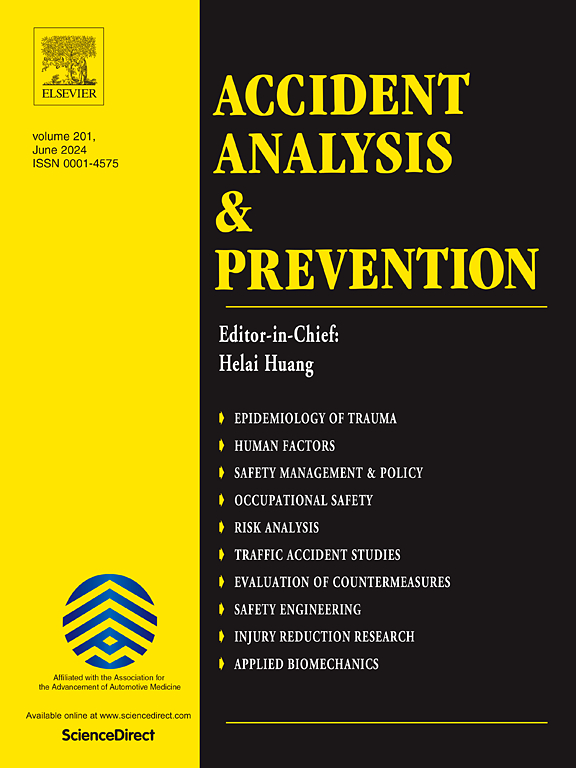利用人类驾驶员脑电图认知数据的可转移知识识别自动驾驶脱离情景
IF 5.7
1区 工程技术
Q1 ERGONOMICS
引用次数: 0
摘要
在无人驾驶的情况下,自动驾驶(AD)技术的采用减少了人为失误,大大提高了驾驶安全性。尽管AD可以很好地处理常见的场景,但在一些例外情况下,由于难以理解或激烈冲突的情况很少发生,AD仍然需要人工接管。为了帮助AD有效地理解和识别脱离驾驶情景,本文将人类脑电图(EEG)认知数据纳入建模,并提出了一种迁移学习框架,使AD能够从手动驾驶(MD)中吸收整合知识。使用驾驶模拟器设计了几种脱离场景,并收集了MD中的“驾驶员”和AD中的“监督者”的脑电图数据。引入条件最大平均差异(CMMD)函数来识别共同的脑活动特征,从而使识别模型从认知要求较高的MD领域转移到认知要求较低的AD领域。结果表明,该模型仅使用30%的AD训练标签,就能在静态障碍物、十字路口冲突和车辆切入等典型脱离场景下实现80%的识别率。与仅使用AD域数据的模型相比,从EEG数据中可转移的公共特征空间将识别精度提高了21.2%。通过准确识别脱离场景的类型,AD系统可以激活适当的安全机制或提供更明确的接管提示,从而有效降低因延迟或错误接管而导致的事故风险。本文章由计算机程序翻译,如有差异,请以英文原文为准。
Recognizing autonomous driving disengagement scenarios using the transferable knowledge from human driver’s EEG cognitive data
Without human participation in driving operations, the adoption of autonomous driving (AD) technology greatly enhances driving safety by reducing human errors. Even though AD can handle common scenarios properly, some exceptions still call for the human takeover with AD failing to engage due to the incomprehensible or intensely conflict situations that rarely occur. To help AD understand and recognize the disengagement scenarios effectively, this paper incorporates the human electroencephalogram (EEG) cognitive data into modeling and proposes a transfer learning framework to let AD absorb the integrative knowledge from the manual driving (MD). Several disengagement scenarios are designed using a driving simulator and EEG data are collected from both “drivers” in MD and “supervisors” in AD. A conditional maximum mean discrepancy (CMMD) function is introduced to identify the common brain activity characteristics, allowing the recognition model to be transferred from the cognitively demanding domain of MD to the less demanding domain of AD. The results indicate that the proposed model can achieve an 80 % recognition rate for typical disengagement scenarios, such as static obstacles, intersection conflict and vehicle cut-in, using only 30 % of AD training labels. The transferable common feature space from EEG data improves the recognition accuracy by 21.2 % compared with the model only using AD domain data. By accurately recognizing the type of disengagement scenarios, the AD system can activate appropriate safety mechanisms or provide more explicit takeover prompts, which could effectively reduce the risk of accidents due to delayed or incorrect takeovers.
求助全文
通过发布文献求助,成功后即可免费获取论文全文。
去求助
来源期刊

Accident; analysis and prevention
Multiple-
CiteScore
11.90
自引率
16.90%
发文量
264
审稿时长
48 days
期刊介绍:
Accident Analysis & Prevention provides wide coverage of the general areas relating to accidental injury and damage, including the pre-injury and immediate post-injury phases. Published papers deal with medical, legal, economic, educational, behavioral, theoretical or empirical aspects of transportation accidents, as well as with accidents at other sites. Selected topics within the scope of the Journal may include: studies of human, environmental and vehicular factors influencing the occurrence, type and severity of accidents and injury; the design, implementation and evaluation of countermeasures; biomechanics of impact and human tolerance limits to injury; modelling and statistical analysis of accident data; policy, planning and decision-making in safety.
 求助内容:
求助内容: 应助结果提醒方式:
应助结果提醒方式:


